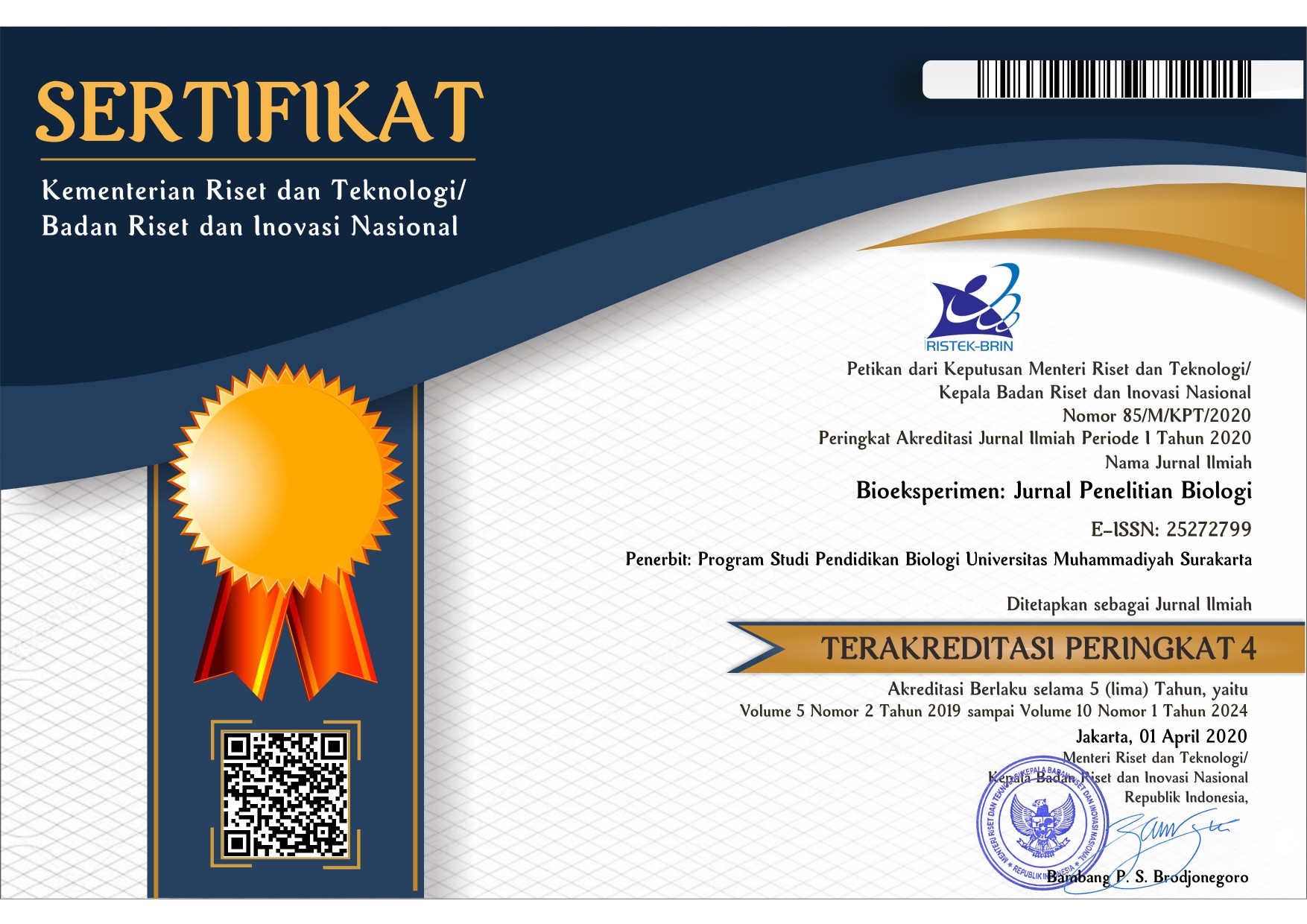Dragonfly Inventory and Active Time in Kasang Kulim Zoo Area, Riau, Indonesia
Miranda Delithalia(1*), Radith Mahatma(2)(1) Department of Biology, Faculty of Mathematics and Natural Sciences, Riau University, Pekanbaru 28293
(2) Department of Biology, Faculty of Mathematics and Natural Sciences, Riau University, Pekanbaru 28293
(*) Corresponding Author
Abstract
Dragonflies have an important role in ecosystem balance as biological control agents and environmental bioindicators because they are sensitive to changes in water quality. Community activities at the Kasang Kulim Zoo can cause changes to water quality. When habitat conditions change, Odonata (dragonfly) will also changes, both in distribution and diversity. This study aims to identify, invent and determine the activity time of dragonflies found in the Kasang Kulim Zoo area. Research was conducted at the end of March to mid-April 2023. Sampling used exploration method by using insect nets. The results obtained a total of 152 individuals belonging to 14 species, four families and two suborders (Anisoptera and Zygoptera). The family Libellulidae totaled eight species, Gomphidae one species, Coenagrionidae four species and Platycnemididae one species. The Libellulidae family are active from 08.00 am to 05.00 pm, while dragonfly species from the Gomphidae family and the Zygoptera suborder are active from 08.00 am to 03.00 pm. Dragonfly activity is influenced by air temperature, air humidity and sunlight intensity.
Keywords
Full Text:
PDFReferences
Acquah D, Kyerematen R, Owus EO. (2013). Using Odonates as Markers of The Environmental Health of Water and It’s Land Related Ecotone. International Journal of Biodiversity and Conservation 5(11): 761-769.
Agustina Y & Yulminarti. (2020). Keanekaragaman dan Kelimpahan Capung (Odonata: Anisoptera) di Hutan Larangan Adat Ghimbo Potai Kabupaten Kampar Provinsi Riau. Repository FMIPA Universitas Riau. 1-13.
Borkenstein A & Jödicke R. (2022). Thermoregulatory Behaviour of Sympetrum striolatum at Low Temperatures with Special Reference to the Role of Direct Sunlight (Odonata: Libellulidae). Odonatologica 51(1): 83-109.
Buchori D, Ardhian D, Salaki LD, Pirnanda D, Agustina M, Pradana EW, Rahadi WS, Nazar L. (2019). Capung KELOLA Sendang: Mengumpulkan Yang Terserak, Merawat Yang Tersisa. Zoological Society of London.
Carvalho F, Pinto NS, Jose OJ, Juen L. (2013). Effects of Marginal Vegetation Removal on Odonata Communities. Acta Limnologica Brasiliensia 25(10).
Castillo-Pérez EU, Suárez-Tovar CM, González-Tokman D, Schondube JE, Córdoba-Aguilar A. (2022). Insect Thermal Limits in Warm and Perturbed Habitats: Dragonflies and Damselflies as Study Cases. Journal of Thermal Biology 103(368).
Dunkle SW. (2000). Dragonflies Through Binoculars: A Field Guide to Dragonflies of North America. New York: Oxford University Press.
Gillot C. (1980). Entomology. New York and London: Plenum Press.
Henry ER, Rivera JA, Linkem CN, Scales JA, Butler MA. (2018). Damselflies that Prefer Dark Habitats Illustrate the Importance of Light as an Ecological Resource. Biological Journal of the Linnean Society 123: 144-154.
Hidayah SNI. (2008). Keanekaragaman dan Aktivitas Capung (Ordo: Odonata) di Kebun Raya Bogor [skripsi]. Fakultas Pertanian, Institut Pertanian Bogor, Bogor.
Irawan A & Rahadi WS. (2016). Capung Sumba. Nusa Tenggara Timur: Balai Taman Nasional Manupeu Tanah Daru dan Laiwangi Wanggameti.
Jumar. (2000). Entomologi Pertanian. Jakarta: Rineka Cipta.
Kaligis KH, Pollo HN, Tulung M. (2023). Penilaian Sumber-daya Alam di Sekitar Danau Pulisan, Linow dan Tampusu, Kota Tomohon, Sulawesi Utara: Capung (Odonata) Sebagai Bio-indikator. Silvarum 2(1): 13-19.
Kalkman VJ & Orr AG. (2013). Field Guide to The Damselflies of New Guinea. Brachytron 16(2): 3-118.
Kalkman VJ, Clausnitzer V, Dijkstra KDB, Orr AG, Paulson DR, Tol JV. (2008). Global Diversity of Dragonflies (Odonata) in Freshwater. Hydrobilogia 595: 351-363.
Khairiyah SMH, Izzati NMR, Faezah P. (2012). Species Richness and Temporal Variation in the Dragonfly and Damselfly Fauna at National Botanical Garden Shah Alam. IEEE Colloquium on Humanities, Science and Engineering (CHUSER) 442-447.
Klym M & Quinn M. (2003). Introduction to Dragonfly and Damselfly Watching. Texas: Texas Parks and Wildlife Department.
May ML. (1976). Thermo-regulation and Adaptation to Temperature in Dragonflies (Odonata: Anisoptera). Ecological Monographs 46(1): 1-32.
Mill PJ & Ward L. (2005). Habitat Factors Influencing the Presence of Adult Calopteryx Splendens (Odonata: Zygoptera). Eur. J. Entomol 102: 47-51.
Oliveira-Junior JMB, De Marco P, Dias-Silva K, Leitao RP, Leal CG, Pompeu PS, Gardner TA, Hughes RM, Juen L. (2017). Effects of Human Disturbance and Riparian Conditions on Odonata (Insecta) Assemblages in Easterns Amazon Basin Streams. Limnologica 66: 31-39.
Orr AG. (2005). Dragonflies of Peninsular Malaysia and Singapore. Malaysia: Natural History Publications (Borneo) Sdn. Bhd.
Pasaribu R & Sari LO. (2019). Perancangan Aplikasi Link Budget Untuk Menghitung Jumlah Enode B di Kabupaten Kampar. JOM FTEKNIK 6(1): 1-6.
Perez ESN & Bautista MG. (2020). Dragonflies in The City: Diversity of Odonates in Urban Davao, Philippines. Journal of Agricultural Science and Technology 10(1): 12-19.
Putri TAM, Wimbaningrum R, Setiawan R. (2019). Keanekaragaman Jenis Capung Anggota Ordo Odonata di Area Persawahan Kecamatan Sumbersari Kabupaten Jember. Bioma 8(1): 324-336.
Rahadi WS, Feriwibisono B, Nugrahani MP, Putri IDB, Makitan T. (2013). Naga Terbang Wendit: Keanekaragaman Capung Perairan Wendit di Malang, Jawa Timur. Malang: Indonesia Dragonfly Society.
Rohr J, Civitello D, Cohen J, Roznik E, Sinervo B, Dell A. (2018). The Complex Drivers of Thermal Acclimation and Breadth in Ectotherms. Ecology letters 21: 1425-1439.
Susanti S. (1998). Seri Panduan Lapangan Mengenal Capung. Bogor: Puslitbang Biologi LIPI.
Syarifah EB, Fitriana N, Wijayanti F. (2018). Keanekaragaman Capung (Odonata) Taman Mini Indonesia Indah dan Taman Margasatwa Ragunan, DKI Jakarta, Indonesia. Bioprospek 13(1): 50-58.
Wulandari ASN, Setyawati TR, Kustiati. (2019). Komposisi Spesies Capung (Odonata) di Kawasan Cagar Alam Mandor Kecamatan Mandor Kabupaten Landak Kalimantan Barat. Protobiont 8(1): 20-26.
Zahner R. (1960). Über die Bindung der mitteleuropäischen Calopteryx-arten (Odonata, Zygoptera) an den Lebensraum des strömenden Wassers. II. Der Anteil der Imagines an der Biotopbindung. Int. Rev. Gesam. Hydrobiol. Hydrogr. 45: 101–123.
Article Metrics
Abstract view(s): 467 time(s)PDF: 354 time(s)
Refbacks
- There are currently no refbacks.








